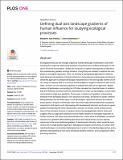Defining dual-axis landscape gradients of human influence for studying ecological processes
Date
18/11/2021Metadata
Show full item recordAbstract
Ecological processes are strongly shaped by human landscape modification, and understanding the reciprocal relationship between ecosystems and modified landscapes is critical for informed conservation. Single axis measures of spatial heterogeneity proliferate in the contemporary gradient ecology literature, though they are unlikely to capture the complexity of ecological responses. Here, we develop a standardized approach for defining multi-dimensional gradients of human influence in heterogeneous landscapes and demonstrate this approach to analyze landscape characteristics of ten ecologically distinct US cities. Using occupancy data of a common human-adaptive songbird collected in each of the cities, we then use our dual-axis gradients to evaluate the utility of our approach. Spatial analysis of landscapes surrounding ten US cities revealed two important axes of variation that are intuitively consistent with the characteristics of multi-use landscapes, but are often confounded in single axis gradients. These were, a hard-to-soft gradient, representing transition from developed areas to non-structural soft areas; and brown-to-green, differentiating between two dominant types of soft landscapes: agriculture (brown) and natural areas (green). Analysis of American robin occurrence data demonstrated that occupancy responds to both hard-to-soft (decreasing with development intensity) and brown-to-green gradient (increasing with more natural area). Overall, our results reveal striking consistency in the dominant sources of variation across ten geographically distinct cities and suggests that our approach advances how we relate variation in ecological responses to human influence. Our case study demonstrates this: robins show a remarkably consistent response to a gradient differentiating agricultural and natural areas, but city-specific responses to the more traditional gradient of development intensity, which would be overlooked with a single gradient approach. Managing ecological communities in human dominated landscapes is extremely challenging due to a lack of standardized approaches and a general understanding of how socio-ecological systems function, and our approach offers promising solutions.
Citation
Padilla , B J & Sutherland , C 2021 , ' Defining dual-axis landscape gradients of human influence for studying ecological processes ' , PLoS ONE , vol. 16 , no. 11 , e0252364 . https://doi.org/10.1371/journal.pone.0252364
Publication
PLoS ONE
Status
Peer reviewed
ISSN
1932-6203Type
Journal article
Collections
Items in the St Andrews Research Repository are protected by copyright, with all rights reserved, unless otherwise indicated.

